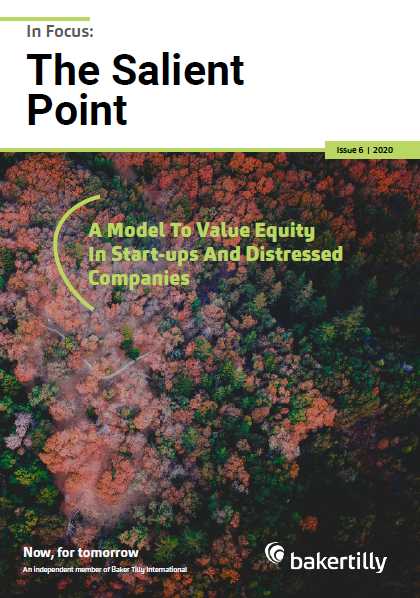Suggested Reading:

In our previous Salient Point (Issue 3), we discussed how a company could go about preparing a cash flow forecast. Such a forecast, as mentioned in that article, could be helpful to improve the company’s cash flow visibility under uncertain times. Additionally, cash flow forecast could be used to determine the value of the business using the discounted cash flow (“DCF”) method. Such a valuation could be used for, amongst other things, fund-raising, impairment assessment and/or reporting to stakeholders.

Businesses currently find themselves in unchartered waters as the Covid-19 pandemic situation continues to persist. Even historically profitable businesses are not spared as supply chains globally are disrupted and the future looks bleak. In particular, small and medium enterprises (“SMEs”) have been hit hard. The SBF-Experian SME Index^, which tracks business sentiment specifically for SMEs in Singapore for the next six months, fell from 50.4 in Jan 2020 to 48.3 in April 2020, reaching an all-time low since the establishment of the index in 2009*. To navigate uncertain times, it is crucial for SMEs to review their existing business plans and cash flow forecasts which may be obsolete given the disruption caused by Covid-19.
A Model to Value Equity in Start-ups and Distressed Companies
By: Adrian Cheow, Executive Director & Practice Leader, Deal Advisory, FCCA ![]()
Avinaash Ravi, Senior Manager, Deal Advisory, CAIA ![]()
Introduction
In valuing the equity of a business, it is common to first estimate the value of the business as a whole. This value is referred to as the enterprise value (“EV”). EV reflects the value of all of a business’ funding sources i.e. all forms of the business’ debt and equity.
There are two traditional approaches that are adopted to estimate an EV of a business. They are (i) the income approach and (ii) the market approach. The income approach involves estimating the value of a business by discounting the forecast income of the business. The market approach involves using value implied from publicly traded companies or transaction to estimate a value for the subject company. Once EV has been estimated, the equity value of most businesses can be derived by deducting the value of the business’ net debt, i.e. the value of the business’ debt minus its cash and cash equivalents. However, for start-ups and companies in distress, moving from EV to equity value in this manner may not be straightforward. This is because:
1. Start-ups tend to have complex capital structure with more than one class of equity, i.e. preference shares and ordinary shares. Consequently, once the value of net debt has been deducted from EV, this total equity value will need to be allocated to the various classes of preference and ordinary shares. There is no standard way of doing this; and
2. For companies in distress, valuing its debt is not a simple exercise. The probability of the company going into liquidation can change from day-to-day. This could have an impact on the credit rating of the company and consequently the market value of the debt. Further, the terms of the debt in distressed companies are usually being renegotiated with its creditors. Depending on the outcome, the value of the debt can vary. Under these circumstances, there is a tool that can be used to help allocate the EV of a business to its equity and debt. It is the option pricing model (“OPM”).
Describing OPM
An option, in this case, we are referring to a call option, is a contract that gives the owner the right, but not the obligation, to purchase an underlying asset at a fixed price (commonly referred to as the strike price) before or at the expiry of the contract.
A call option can have various features. However, the key ones are:
1. Owning an option, rather than the underlying asset, limits downside risk. This is because the holder of the call option is not obligated to purchase the asset if it’s below the strike price;
2. Owning an option allows the holder to participate in any upside in the underlying asset’s value as he/she can buy the asset at a pre-specified strike price; and
3. An option will have value even if the price of the underlying is below the strike price as long as there is a non-insignificant probability that the underlying asset’s price may exceed the strike price before the expiry of the contract.
An OPM is a model that allows us to value such a call option. To be clear, there are various OPMs that can be used to value options. Different models are used depending on the terms of the call option contract. In here, when we refer to OPMs, we are referring to the totality of all the models as their purpose is the same – to value options.
Relevance of OPM in valuing equity in start-ups and distressed companies
Start-ups
Typically, equity holders in start-ups realise a return at the point of a liquidity event, such a merger or acquisition. At this liquidity even, the amount realised by the sellers will need to be distributed to the various preference and ordinary shareholders. The distribution mechanics is usually set out in the shareholders’ agreement.
In general, the senior shareholders get the first payout up to a limit that is usually referred to as the liquidation preference. If the amount for distribution is greater than this, the junior preference shareholders get their share up to their liquidation preference. If there is amount left after these distributions, the ordinary shareholders get the remaining. This distribution could be further complicated by whether the preference shareholders haventhe option to convert to ordinary shares and participate in this final round of distribution.
Given these mechanics, we can model each tranche of preference and ordinary share as a call option. Each tranche would have the features of a call option discussed above:
1. Their downside is limited to the contributions they have made;
2. They can participate in the upside as long as the amount for distribution is in excess of the senior tranche’s liquidation preference, i.e. the strike price; and
3. Typically, the higher the time to the liquidity event, the higher the value to the lower tranches as it provides more time for the company’s value to increase before the liquidity event.
In this way, by treating the various tranches of preference and ordinary shares as a call option, OPM can be used to value them.
Distressed companies
It is possible that, at the time the company is in distress, the value its entire business is less than the face value of the debt. As discussed earlier, the terms of the debt in distressed companies is usually being renegotiated. Particularly to extend the repayment terms. If these discussions are successful, this would provide an opportunity for the equity holders to turn the business around and increase the EV to a level that’s higher than the face value of the debt, by the time the debt becomes due.
Conclusion
In these situations, the equity in such companies would have the features of a call option:
1. The downside is limited to the contribution already made by these equity holders;
2. If the business is successfully turned around, the upside benefit would mostly accrue to the equity holders; and
3. The more time the creditors provide to the equity holders for the repayment of their loans, the higher is the value of the equity as this would provide more time for the equity holders to turn the business around. Here too, by treating the equity as a call option, OPM can be used to value it.
Concluding comments
OPM has its appeal. This model explicitly considers the option-like payoff of equity. Further, the model, in general, is simple to implement and requires few inputs. However, there are certain limitations. OPM makes certain simplistic assumptions about the movement of the value of the underlying equity/EV in the future which may not be applicable in all situations. Further, it may not be possible to model all of the features of the equity in the OPM.
Therefore, a careful study needs to be conducted before adopting this model for the purposes of valuing equity in start-ups and distressed companies.
How We Can Help
If you are conducting a valuation of a start-up or distressed company for the purposes of investment, sale or reporting, please contact our Deal Advisory department for assistance.
Get in touch with the author(s):


Adrian Cheow
Executive Director & Practice Leader
Deal Advisory![]() | Email
| Email
Download The Salient Point - A Model to Value Equity in Start-ups and Distressed Companies:
>> Back to The Salient Point>> Main Page
DISCLAIMER: All opinions, conclusions, or recommendations in this article are reasonably held by Baker Tilly at the time of compilation but are subject to change without notice to you. Whilst every effort has been made to ensure the accuracy of the contents in this article, the information in this article is not designed to address any particular circumstance, individual or entity. Users should not act upon it without seeking professional advice relevant to the particular situation. We will not accept liability for any loss or damage suffered by any person directly or indirectly through reliance upon the information contained in this article.



